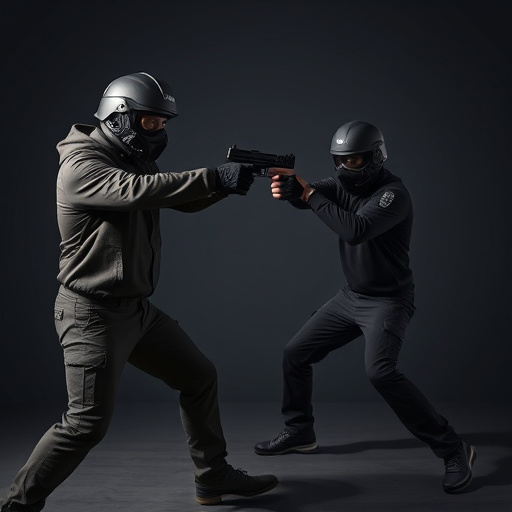Rechargeable stun devices, appealing for eco-conscious self-defense, disrupt nerve signals to immobilize muscles for 3-5 minutes, with variability based on power, area targeted, and user health. Device effectiveness depends on type, user attributes, technique, and environmental conditions. Legal regulations, training, maintenance, and safety considerations are crucial for responsible use of these devices, which require adherence to local laws and proper handling to prevent accidents.
“Uncover the impact of stun guns on muscle incapacitation and explore the duration of their effects. In today’s world, self-defense tools like rechargeable stun devices are gaining popularity. This article delves into what happens when you’re hit with a stun gun, focusing on the length and influencing factors of muscle immobilization.
We’ll examine the rise in rechargeable stun devices for sale and their potential advantages while also discussing legal considerations and safety precautions. By understanding these aspects, individuals can make informed decisions regarding personal safety.”
- Understanding Muscle Incapitation: What Happens When You're Stun Gunned?
- Rechargeable Stun Devices: A Popular Choice for Self-Defense
- Duration of Effects: How Long Does Muscle Incapitation Last?
- Factors Influencing Stun Gun Effectiveness and Downtime
- Legal Considerations and Safety Precautions with Rechargeable Stun Devices
Understanding Muscle Incapitation: What Happens When You're Stun Gunned?

When someone is subjected to a stun gun, the device delivers an electric current that disrupts the body’s nerve signals and muscle control. This sudden jolt of electricity targets the nervous system, specifically affecting the motor neurons that communicate with muscles. The result is immediate muscle incapacitation, causing the individual to lose control over their muscular movements.
Rechargeable stun devices for sale often claim varying durations of this incapacitation, but the effect typically lasts from a few seconds to a minute or so. During this period, the person may experience involuntary contractions, loss of balance, and general disorientation. Understanding these effects is crucial when considering the use of such devices as a temporary defense mechanism.
Rechargeable Stun Devices: A Popular Choice for Self-Defense

Rechargeable stun devices have gained significant popularity as a preferred self-defense tool among individuals seeking effective personal safety measures. These devices offer several advantages over traditional non-rechargeable models, making them an attractive option for those looking to stay prepared and protect themselves. One of the primary benefits is their eco-friendly nature; rechargeables eliminate the need for frequent battery replacements, reducing waste. This feature aligns with modern consumers’ growing awareness of sustainability.
Additionally, rechargeable stun devices for sale often come at competitive prices, making them accessible to a broader market. The convenience of charging these devices allows users to always be ready when needed, ensuring that the device is fully charged and operational. With advanced technology, these stun guns can deliver powerful jolts while remaining compact and portable, fitting easily in pockets or purses for quick access during emergencies.
Duration of Effects: How Long Does Muscle Incapitation Last?

The duration of muscle incapacitation caused by a stun gun can vary significantly depending on several factors, including the device’s power output, the area targeted, and the individual’s overall health. On average, the effects of a stun gun are intended to be temporary, lasting anywhere from 3 to 5 minutes. However, for individuals with specific medical conditions or those who have received higher voltage doses, the immobilization can extend beyond this timeframe.
When considering rechargeable stun devices for sale, it’s crucial to understand that these tools are designed to disrupt muscle control and cause temporary paralysis. The longer duration of incapacitation is often a result of concentrated electrical pulses that override the body’s natural nerve signals. This disruption can significantly hinder an individual’s ability to move or defend themselves, making them vulnerable during the period of influence.
Factors Influencing Stun Gun Effectiveness and Downtime

The effectiveness and downtime of stun guns can vary significantly based on several factors. One key consideration is the type of stun gun, with rechargeable stun devices for sale offering advantages in terms of cost-efficiency and convenience. These devices often utilize modern technology, such as advanced electrochemical cells and optimized circuit designs, to deliver powerful jolts while minimizing energy consumption.
Additionally, factors like the user’s body mass index (BMI), physical fitness level, and the stun gun’s contact point play crucial roles. Proper placement of the device—for example, targeting pressure points or nerve endings—can significantly enhance its impact. The user’s muscle tone and strength can also influence incapacitation duration, as stronger muscles may recover faster from the stun. Environmental conditions, such as temperature and humidity, might affect the stun gun’s performance by impacting battery life and electrical conductivity.
Legal Considerations and Safety Precautions with Rechargeable Stun Devices

The use of rechargeable stun devices for sale has gained popularity as personal safety tools, but it’s crucial to understand the legal landscape surrounding their deployment. Many regions have specific regulations and restrictions on stun guns, including requirements for permits, age limitations, and prohibited areas where their use is restricted or forbidden. Before purchasing a rechargeable stun device, individuals should thoroughly research and comply with local laws to avoid legal repercussions.
Safety precautions are paramount when handling any type of stun device. Users must be trained in proper usage, ensuring they understand the range, power settings, and de-activation mechanisms. Rechargeable models offer convenience but also require careful management to prevent accidents or misuse. Regular maintenance and inspections can help keep these devices reliable and safe for intended purposes while minimizing potential risks.
In conclusion, understanding the duration of muscle incapacitation from stun guns, particularly rechargeable stun devices for sale, is crucial for self-defense preparedness. While these devices offer a non-lethal option, their effectiveness and downtime vary based on factors like power output, target size and location, and individual sensitivity. Always prioritize safety by adhering to legal considerations and employing proper handling techniques. Investing in high-quality rechargeable stun devices can provide peace of mind, ensuring you’re prepared for unexpected situations where muscle incapacitation may be necessary to gain time or escape harm.
